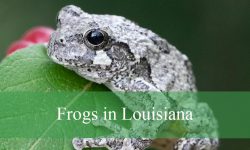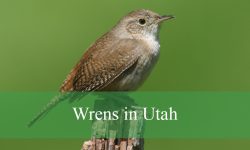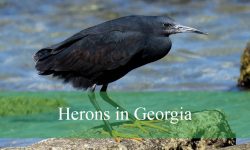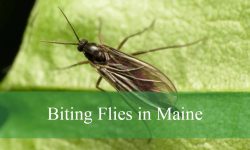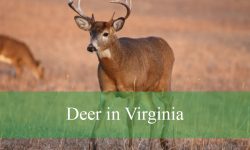Maine is home to a diverse array of woodpecker species, from the tiny Downy Woodpecker to the majestic Pileated Woodpecker. Their striking plumage, drumming sounds, and unique behaviors make them fascinating to observe for birdwatchers and nature enthusiasts alike.
These woodpeckers inhabit a variety of landscapes, including dense forests, open woodlands, and even suburban areas with scattered trees. Each species has distinct markings, feeding habits, and calls, making identification both rewarding and educational.
In this guide, we explore 10 woodpecker species found in Maine, providing detailed descriptions, identification tips, and stunning photographs to help you spot them in the wild.
Types of Woodpeckers Found in Maine
Downy Woodpecker (Picoides pubescens)

The Downy Woodpecker is the smallest woodpecker found in Maine, measuring about 6–7 inches in length with a wingspan of roughly 10–12 inches. It has a short, chisel-like bill and distinctive black-and-white plumage. Males show a small red patch on the back of the head, while females lack this mark. Its compact size and rounded head make it easily distinguishable from similar species.
This woodpecker is highly recognizable by its black-and-white striped head, white back, and spotted black wings. Its tail feathers are stiff, aiding in balance as it clings to tree trunks. Downy Woodpeckers often exhibit rapid, jerky movements while foraging and are frequently seen hopping along branches, probing bark crevices for insects.
Downy Woodpeckers primarily feed on insects, including beetle larvae, ants, and caterpillars, but they also consume seeds, berries, and suet from feeders in winter. They exhibit typical woodpecker behavior, drumming on tree trunks and branches to communicate and to excavate food. They are known for their adaptability and often visit suburban areas, parks, and gardens.
For nesting, Downy Woodpeckers excavate cavities in dead or decaying trees, preferring soft wood. Breeding pairs lay 3–8 eggs, and both parents incubate them and feed the hatchlings. They inhabit a variety of habitats in Maine, including deciduous and mixed forests, edge habitats, orchards, and even urban areas with scattered trees.
Hairy Woodpecker (Picoides villosus)
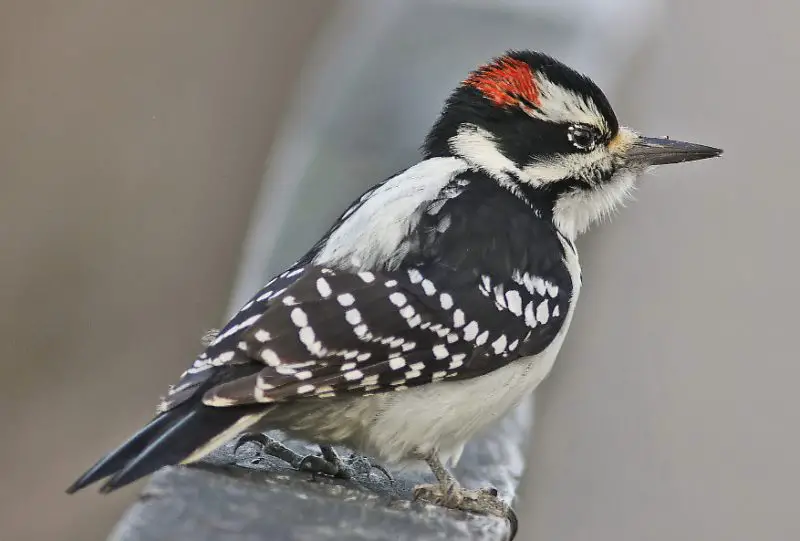
The Hairy Woodpecker is larger than the Downy, measuring about 9–10 inches in length with a wingspan of 16–18 inches. It has a straight, powerful bill that is nearly the same length as its head. Males display a bright red patch on the back of the head, while females lack this feature. Its longer bill and larger size help distinguish it from the Downy Woodpecker.
Hairy Woodpeckers have a similar black-and-white plumage to Downys but with broader white patches on the back and proportionally longer bills. Their tails are also stiff, which helps them cling to vertical surfaces as they search for food. They often drum loudly on trees, communicating territory and readiness to breed.
This species mainly feeds on insects, including wood-boring beetles and caterpillars, but they will also eat seeds and berries when insects are scarce. They are expert foragers, drilling deep into wood to extract insects, and are often observed tapping branches and trunks with precise, rhythmic movements.
Hairy Woodpeckers excavate nesting cavities in dead or dying trees, usually higher off the ground than Downys. They lay 4–6 eggs, which are incubated by both parents. Their habitat in Maine spans mature forests, wooded suburbs, and parklands, favoring larger trees and forested areas compared to Downy Woodpeckers.
Northern Flicker (Colaptes auratus)

The Northern Flicker is a medium-sized woodpecker, measuring 11–14 inches in length with a wingspan of 16–20 inches. It has a slightly curved bill and a brownish body with black spots, bars, and a distinctive black bib on the chest. The yellow-shafted morph in Maine shows bright yellow underwing and tail feathers, visible in flight. Males have a red crescent on the nape.
Flickers are strikingly different from other woodpeckers due to their ground-feeding behavior and barred brown back. Their faces feature black malar stripes, and they have a distinctive white rump patch that flashes in flight. Their size and coloration make them unmistakable compared to smaller, more black-and-white species.
Northern Flickers feed heavily on ants and beetles, often foraging on the ground by hammering and digging into soil. They also consume fruits, seeds, and berries. Their drumming behavior on trees or metal poles is used to mark territory, and they are very vocal, producing loud, repeated calls.
These woodpeckers nest in tree cavities, often preferring dead trees but sometimes utilizing wooden utility poles. They lay 5–8 eggs per clutch, with both parents sharing incubation duties. In Maine, Northern Flickers are common in mixed forests, open woodlands, suburban areas, and along forest edges, often seen perched on the ground or foraging near lawns and parks.
Pileated Woodpecker (Dryocopus pileatus)
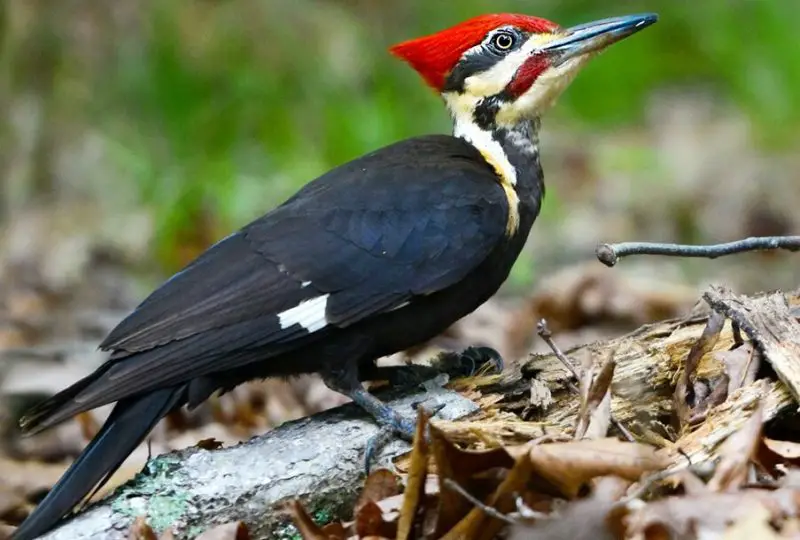
The Pileated Woodpecker is Maine’s largest woodpecker, measuring 16–19 inches in length with a wingspan of 26–30 inches. It is striking with a mostly black body, white underwing linings, and a prominent red crest. Males also have a red stripe on the cheek, while females’ cheeks are black. Its large size and dramatic appearance make it unmistakable.
Pileated Woodpeckers have a strong, chisel-like bill and powerful neck muscles, allowing them to excavate large rectangular holes in trees. Their flight is slow and undulating, and they drum loudly, creating resonant sounds that can be heard across the forest. Their striking call is a loud, ringing “cuk-cuk-cuk.”
This species feeds primarily on carpenter ants, beetle larvae, and other insects, often digging deep into rotting wood to find prey. They also eat berries and nuts. Pileated Woodpeckers are highly territorial, often defending large forested territories against intruders.
For nesting, Pileated Woodpeckers excavate large cavities in standing dead trees, often used year after year. Clutch size is typically 3–5 eggs, incubated by both parents. Their preferred habitat in Maine includes mature deciduous and mixed forests, particularly areas with large standing dead trees and fallen logs, though they occasionally visit suburban wooded areas.
Red-bellied Woodpecker (Melanerpes carolinus)
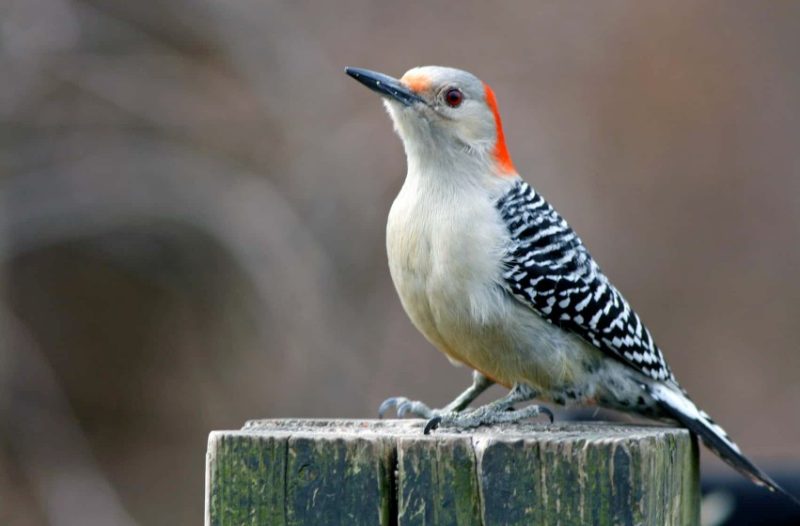
The Red-bellied Woodpecker is medium-sized, around 9–10 inches in length with a wingspan of 13–16 inches. It has a pale face, black-and-white barred back, and a faint red wash on the belly, often hard to see. Males show a bright red crown extending from the bill to the nape, while females have red only on the nape.
This woodpecker is highly distinctive due to its bold black-and-white striped back and red crown. Its flight is strong and direct, revealing white underwing patches. Its calls include rolling “churr” sounds, and it drums on dead trees or wooden structures to communicate and defend territory.
Red-bellied Woodpeckers feed on insects, nuts, fruits, and seeds. They are frequent visitors to backyard feeders, especially those offering suet and peanuts. They often forage on tree trunks and branches, sometimes hanging upside down to reach hidden insects.
For nesting, they excavate cavities in dead or decaying trees or use natural holes. Clutch sizes are typically 4–6 eggs, incubated by both parents. In Maine, this species is expanding its range, now appearing in suburban woodlands, parks, and forest edges, favoring areas with a mix of mature trees and open spaces.
Yellow-bellied Sapsucker (Sphyrapicus varius)
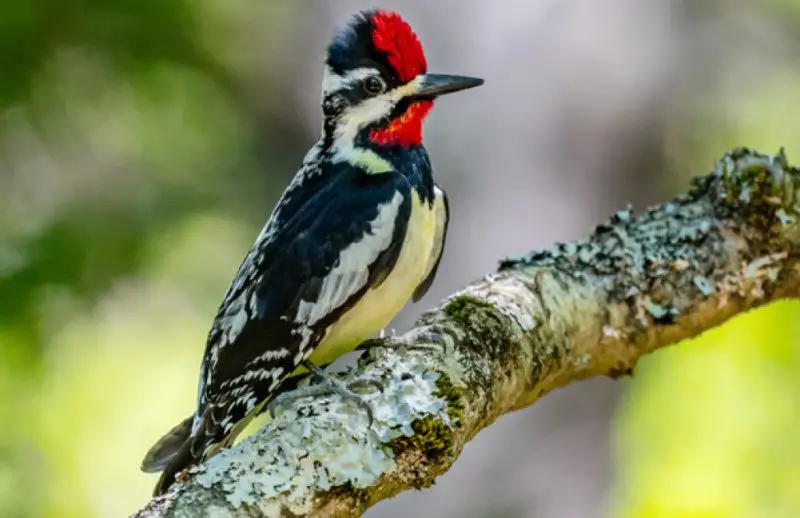
The Yellow-bellied Sapsucker is a medium-sized woodpecker, measuring about 7–8 inches in length with a wingspan of 12–14 inches. Males have a red forehead and throat, while females show a red forehead but a pale throat. Its belly is lightly yellow-tinged, giving the species its name. Its black-and-white patterned back and striking facial markings make it easily identifiable.
This species is recognized by its distinctive black-and-white head pattern, barred back, and bold wing markings. In flight, its white wing patches are conspicuous, and its call is a harsh “wick-wick” sound. They are often seen perching upright on tree trunks, moving deliberately while tapping and drilling shallow holes.
Yellow-bellied Sapsuckers primarily feed on tree sap, which they access by drilling neat rows of small holes in bark. They also consume insects attracted to the sap, fruits, and berries. Their feeding behavior creates “sap wells,” which other wildlife such as hummingbirds and insects utilize, making them an important ecological contributor.
For nesting, they excavate cavities in live or dead trees, often in aspen, birch, or maple. Both parents incubate 4–7 eggs and care for the young. In Maine, Yellow-bellied Sapsuckers are found in mixed and deciduous forests, especially near wet areas, and are migratory, appearing mainly in spring and fall.
Black-backed Woodpecker (Picoides arcticus)

The Black-backed Woodpecker is a medium-sized, mostly black woodpecker, about 9–10 inches long with a wingspan of 16–18 inches. Males have a small yellow patch on the crown, while females lack this feature. Its uniform black back and contrasting white underparts make it distinct, especially in boreal forests.
This woodpecker has a straight, chisel-like bill suited for digging into bark and wood. Its flight is undulating, and its tail is stiff, aiding in vertical clinging. Black-backed Woodpeckers are less conspicuous than other species due to their dark plumage, but their drumming and sharp calls reveal their presence.
Their diet consists largely of beetle larvae and other wood-boring insects, particularly in burned or recently dead forests where insect populations are high. They forage by chiseling into charred bark, playing a key role in post-fire forest ecology. They occasionally eat fruits and seeds but are primarily insectivorous.
Nesting occurs in dead trees, often in burned forest areas, where they excavate cavities 10–50 feet above the ground. Clutches usually contain 3–5 eggs, incubated by both parents. In Maine, Black-backed Woodpeckers are associated with coniferous forests, especially spruce and fir stands, and are uncommon but locally regular in burned or disturbed habitats.
American Three-toed Woodpecker (Picoides dorsalis)

The American Three-toed Woodpecker is medium-sized, measuring 8–9 inches in length with a wingspan of 14–17 inches. It is mainly black with white underparts, a black-streaked back, and a prominent yellow crown patch on males. Females have less or no yellow on the crown. Its smaller size and three-toed foot distinguish it from similar woodpeckers.
This species is identified by its black-and-white barred back, white belly, and yellow crown (male). Its flight is undulating, and it often clings vertically to tree trunks and dead wood. Its drumming is sharp and rapid, used for both communication and foraging.
American Three-toed Woodpeckers primarily feed on bark beetle larvae and other insects found in dead or dying conifers. They are often associated with recently burned or beetle-infested forests, where they can be seen chiseling deeply into bark to extract prey. They occasionally eat sap or fruit when insects are scarce.
They nest in cavities excavated in standing dead trees, usually conifers. Clutch size is typically 3–6 eggs, with both parents incubating and feeding the young. In Maine, they are found in mature boreal forests, spruce-fir stands, and areas affected by fire or insect outbreaks, making them an uncommon but specialized species.
Red-headed Woodpecker (Melanerpes erythrocephalus)
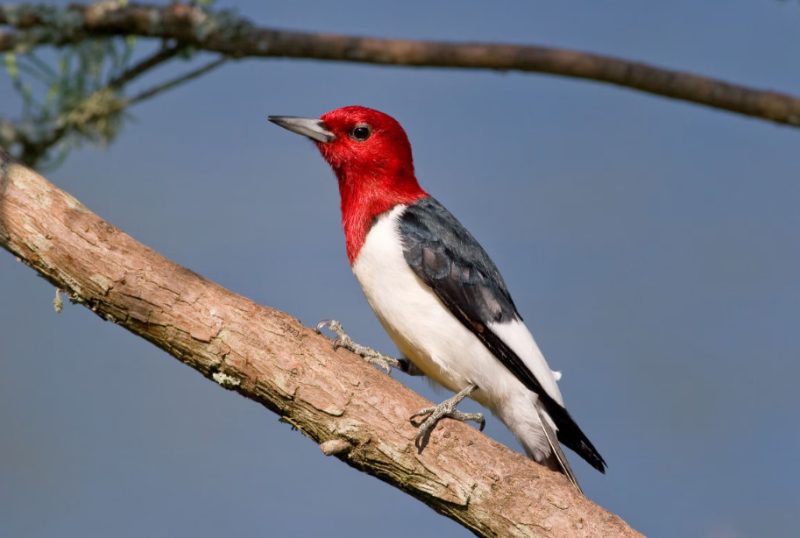
The Red-headed Woodpecker is a medium-sized bird, about 8–10 inches long with a wingspan of 16–18 inches. Adults have a striking solid red head, black back and wings, and white underparts and wing patches. Its bold coloration makes it one of the most visually stunning woodpeckers in Maine.
This species has a strong, straight bill and a robust body, adapted for catching insects and handling nuts and fruits. In flight, the contrasting black-and-white wings and red head are easily visible. Its vocalizations are a variety of harsh “churr” and “kwirr” sounds, often heard during the breeding season.
Red-headed Woodpeckers are omnivorous, feeding on insects, nuts, fruits, seeds, and occasionally small vertebrates. They are known to cache food in tree crevices, a behavior that helps them survive the winter. They are often seen foraging on dead trees or utility poles, as well as open woodlands and edges.
Nesting occurs in tree cavities, which they excavate themselves or occasionally use abandoned ones. Clutch size is 4–7 eggs, and both parents participate in incubation and feeding. In Maine, this species is uncommon but increasing, found in open deciduous forests, forest edges, and areas with scattered trees and standing deadwood.
Lewis’s Woodpecker (Melanerpes lewis)
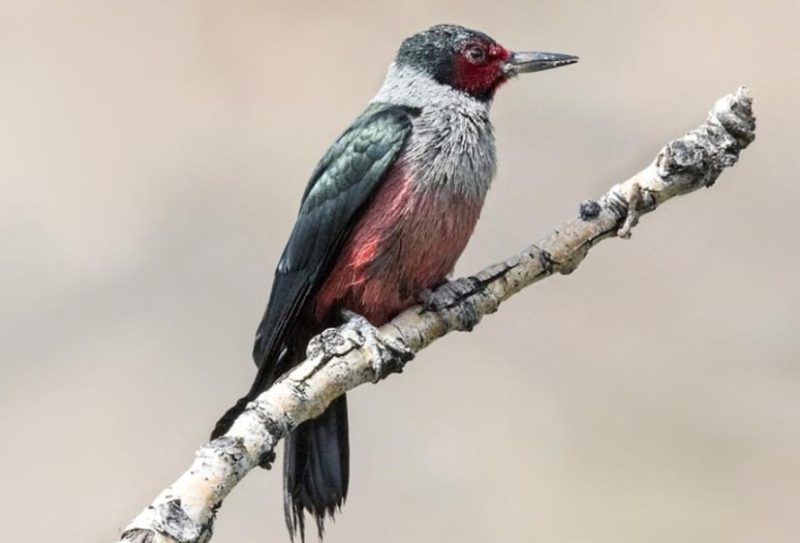
Lewis’s Woodpecker is a medium-large woodpecker, about 10–11 inches in length with a wingspan of 16–18 inches. It has a unique dark greenish-black back, pinkish belly, gray face, and red head. Its long, broad wings give it a more falcon-like flight compared to other woodpeckers, and it often glides more than hops.
This species is easily identifiable by its unusual plumage combination and slow, deliberate flight. Unlike typical woodpeckers, it frequently catches insects in the air, hawking like a flycatcher. Its call is a low, nasal “kow” sound, used to communicate with mates and defend territory.
Lewis’s Woodpecker feeds on insects, especially flying beetles and moths, which it catches midair, as well as fruits and nuts. It is less dependent on tree-drilling than other woodpeckers, often perching openly to sally for prey. This aerial feeding behavior is a key trait distinguishing it from other Maine woodpeckers.
They nest in tree cavities, often in snags or dead trees, laying 4–7 eggs per clutch. Both parents incubate and feed the young. In Maine, Lewis’s Woodpecker is extremely rare, typically associated with open pine or burned forests, and is considered a vagrant species with very limited occurrence.
FAQs About Woodpeckers in Maine
What types of woodpeckers are commonly found in Maine?
Maine hosts a variety of woodpecker species. The most common include the Downy Woodpecker, Hairy Woodpecker, Northern Flicker, and Pileated Woodpecker. Other species, such as the Red-bellied Woodpecker and Yellow-bellied Sapsucker, are increasing in range, while species like Lewis’s Woodpecker are rare vagrants. Each species occupies specific habitats, from dense forests to suburban areas.
How can I tell the difference between Downy and Hairy Woodpeckers?
While both species have similar black-and-white plumage, the Downy Woodpecker is smaller (6–7 inches) with a shorter bill, whereas the Hairy Woodpecker is larger (9–10 inches) with a long, straight bill nearly as long as its head. Downys are more common in suburban areas, while Hairys prefer mature forests. Observing size, bill length, and foraging behavior helps distinguish them.
Where are Pileated Woodpeckers typically found in Maine?
Pileated Woodpeckers prefer large, mature deciduous and mixed forests with standing dead trees or fallen logs. They are most commonly seen in forested areas but occasionally venture into wooded suburban neighborhoods. Their large size, loud drumming, and prominent red crest make them easy to identify even from a distance.
What do woodpeckers eat in Maine?
Woodpeckers are primarily insectivorous, feeding on beetle larvae, ants, and other wood-boring insects. Many species also eat fruits, nuts, seeds, and sap. Northern Flickers are known for feeding on ants on the ground, while Lewis’s Woodpecker catches insects midair. In winter, backyard feeders with suet or peanuts can attract several species.
How do woodpeckers nest in Maine?
Most Maine woodpeckers excavate cavities in dead or decaying trees to nest. Both parents usually incubate eggs and feed the young. Clutch sizes vary by species, typically ranging from 3 to 8 eggs. Some species, like Red-headed Woodpeckers, may reuse cavities, while sapsuckers create shallow wells that other wildlife also utilize.
When is the best time to see woodpeckers in Maine?
Woodpeckers are most active during the breeding season in spring and early summer when they drum frequently to defend territories. Migratory species, like the Yellow-bellied Sapsucker, are best seen during spring and fall migrations. Many species can also be observed year-round, particularly in winter at feeders or in forests with standing dead trees.
Why do woodpeckers drum on trees?
Drumming serves multiple purposes. It helps woodpeckers communicate with mates, establish territory, and locate insects beneath bark. The rhythm and volume of drumming vary by species. Pileated and Hairy Woodpeckers, for example, create loud, resonant drumming, while smaller species like Downys produce quicker, softer taps.
Are woodpeckers beneficial to Maine forests?
Yes, woodpeckers play a crucial ecological role by controlling insect populations, creating nesting cavities for other species, and dispersing seeds. Species like Yellow-bellied Sapsuckers create sap wells that provide food for insects, hummingbirds, and other wildlife. Their foraging and nesting behavior support forest biodiversity.
Can woodpeckers damage homes or trees?
While woodpeckers mainly target dead or dying trees, they may occasionally peck on siding, utility poles, or wooden structures, particularly during the breeding season. Using deterrents such as reflective tape, decoys, or protective netting can help prevent damage without harming the birds.

